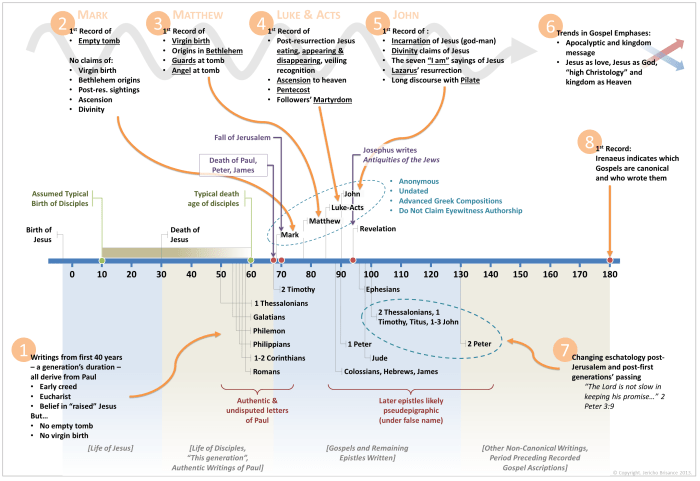The god-man christ in the gospels answer key pdf – The “God-Man Christ in the Gospels Answer Key PDF” provides a comprehensive examination of the nature of Jesus Christ as portrayed in the Gospels. This in-depth analysis explores the historical context, literary genre, and theological significance of the Gospels, shedding light on the intricate interplay between Christ’s divinity and humanity.
Through a meticulous examination of scriptural evidence, the answer key illuminates the ways in which the Gospels present Christ as both fully divine and fully human. It delves into the implications of Christ’s dual nature for Christian faith and practice, offering a deeper understanding of the central figure of Christianity.
The Historical Context of the Gospels
The Gospels were written during a period of significant political, social, and religious change in the Roman Empire. The Roman Empire was at its peak, and its influence extended throughout the Mediterranean region. This period also saw the rise of Christianity, a new religion that challenged the traditional Roman beliefs.
The political climate of the Roman Empire was characterized by a series of emperors who ruled with absolute power. The emperors were often seen as gods, and they demanded the loyalty of their subjects. This created a conflict with Christianity, which taught that there was only one God and that Jesus Christ was his son.
The social climate of the Roman Empire was also complex. The empire was divided into a rigid class system, with the wealthy elite at the top and the poor and enslaved at the bottom. Christianity offered a message of hope to the poor and oppressed, and it quickly gained a following among these groups.
The religious climate of the Roman Empire was also changing. The traditional Roman gods were losing their popularity, and people were beginning to look for new spiritual beliefs. Christianity offered a new and compelling alternative to the old Roman religion, and it quickly gained a following among the Roman people.
The Literary Genre of the Gospels
The Gospels are a unique type of literature. They are not historical accounts in the modern sense, nor are they biographies of Jesus Christ. Rather, the Gospels are a collection of stories, parables, and teachings that were written to proclaim the good news of Jesus Christ.
The Gospels are written in a style that is both simple and profound. They are full of vivid imagery and concrete examples, which makes them easy to understand and remember. The Gospels also use a variety of literary devices, such as metaphors, similes, and hyperbole, to convey their message.
The literary genre of the Gospels affects their interpretation. The Gospels are not meant to be read as historical accounts, but rather as a proclamation of the good news of Jesus Christ. They are meant to be read with faith and devotion, and they should be interpreted in light of the Christian tradition.
The Divinity of Christ in the Gospels

The Gospels provide ample evidence to support the divinity of Jesus Christ. Jesus is portrayed as the Son of God, the one who is equal to God, and the one who has come to save the world from sin.
One of the most striking pieces of evidence for the divinity of Christ is his miracles. Jesus performed many miracles, such as healing the sick, raising the dead, and calming the storms. These miracles demonstrate Jesus’ power over nature and his ability to do the impossible.
Another piece of evidence for the divinity of Christ is his teachings. Jesus taught with authority and power, and his teachings were often met with amazement and wonder. Jesus taught about the kingdom of God, the love of God, and the forgiveness of sins.
His teachings have had a profound impact on the world, and they continue to inspire and challenge people today.
The Humanity of Christ in the Gospels: The God-man Christ In The Gospels Answer Key Pdf
The Gospels also provide ample evidence to support the humanity of Jesus Christ. Jesus was born of a woman, he lived a human life, and he died a human death.
One of the most striking pieces of evidence for the humanity of Christ is his suffering. Jesus suffered greatly during his life, both physically and emotionally. He was betrayed by his friends, he was tortured by the Romans, and he died on the cross.
Jesus’ suffering demonstrates that he was truly human, and that he understands the pain and suffering of the world.
Another piece of evidence for the humanity of Christ is his emotions. Jesus experienced a wide range of emotions, including joy, sorrow, anger, and compassion. Jesus’ emotions demonstrate that he was truly human, and that he shared the full range of human experiences.
The Miracles of Christ in the Gospels
The Gospels record many miracles that Jesus performed. These miracles demonstrate Jesus’ power over nature and his ability to do the impossible.
- Jesus healed the sick. He healed people of all kinds of diseases, including leprosy, blindness, and paralysis.
- Jesus raised the dead. He raised Lazarus from the dead, and he also raised the daughter of Jairus from the dead.
- Jesus calmed the storms. He calmed the storm on the Sea of Galilee, and he also calmed the storm on the way to Gerasa.
- Jesus multiplied the loaves and fishes. He multiplied five loaves and two fish to feed a crowd of over 5,000 people.
- Jesus walked on water. He walked on the Sea of Galilee, and he also walked on the water to meet his disciples.
The miracles of Jesus are a sign of his divinity. They demonstrate that Jesus is the Son of God, and that he has come to save the world from sin.
The Teachings of Christ in the Gospels

The Gospels record the teachings of Jesus Christ. Jesus taught about the kingdom of God, the love of God, and the forgiveness of sins.
Jesus taught that the kingdom of God is a present reality. He said that the kingdom of God is within us, and that it is a realm of peace, joy, and love.
Jesus taught that God is love. He said that God loves us unconditionally, and that he desires to have a relationship with us.
Jesus taught that we should forgive our sins. He said that God forgives us when we sin, and that we should forgive others when they sin against us.
The teachings of Jesus have had a profound impact on the world. They have inspired people to love one another, to forgive one another, and to seek peace and justice.
The Death and Resurrection of Christ in the Gospels

The Gospels record the death and resurrection of Jesus Christ. Jesus died on the cross, and he rose from the dead three days later.
Jesus’ death on the cross was a sacrifice for our sins. He died to pay the penalty for our sins, and to make it possible for us to be forgiven.
Jesus’ resurrection from the dead was a victory over sin and death. He rose from the dead to show that he is the Son of God, and that he has conquered death.
The death and resurrection of Jesus Christ are the central events of the Christian faith. They demonstrate Jesus’ love for us, and they give us hope for eternal life.
The Impact of the Gospels on Christianity

The Gospels have had a profound impact on the development of Christianity. The Gospels have shaped Christian beliefs, practices, and institutions.
The Gospels have shaped Christian beliefs. The Gospels teach us about who Jesus is, what he did, and what he taught. They provide us with the foundation for our faith.
The Gospels have shaped Christian practices. The Gospels teach us how to live as Christians. They teach us to love one another, to forgive one another, and to seek peace and justice.
The Gospels have shaped Christian institutions. The Gospels have been used to establish churches, schools, and hospitals. They have also been used to inspire missionaries to go out into the world and share the good news of Jesus Christ.
The Gospels continue to have a profound impact on Christianity today. They are the foundation of our faith, they guide our practices, and they inspire our institutions.
Expert Answers
What is the purpose of the “God-Man Christ in the Gospels Answer Key PDF”?
The “God-Man Christ in the Gospels Answer Key PDF” is designed to provide a comprehensive understanding of the nature of Jesus Christ as presented in the Gospels, exploring both his divine and human aspects.
How does the answer key support the understanding of Christ’s divinity?
The answer key draws upon scriptural evidence from the Gospels to demonstrate how they portray Christ as fully divine, possessing divine attributes and authority.
In what ways does the answer key address the humanity of Christ?
The answer key examines passages in the Gospels that depict Christ’s human experiences, emotions, and interactions, highlighting his genuine humanity.
What is the significance of understanding Christ’s dual nature?
Comprehending Christ’s dual nature is crucial for grasping the Christian faith’s central tenets, as it illuminates the unique role of Jesus as both the divine Son of God and the human savior.